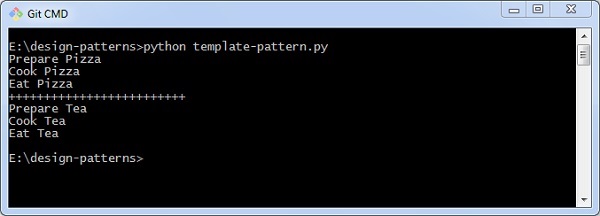Python Design Patterns – Template
A template pattern defines a basic algorithm in a base class using abstract operation where subclasses override the concrete behavior. The template pattern keeps the outline of algorithm in a separate method. This method is referred as the template method.
Following are the different features of the template pattern −
-
It defines the skeleton of algorithm in an operation
-
It includes subclasses, which redefine certain steps of an algorithm.
class MakeMeal: def prepare(self): pass def cook(self): pass def eat(self): pass def go(self): self.prepare() self.cook() self.eat() class MakePizza(MakeMeal): def prepare(self): print "Prepare Pizza" def cook(self): print "Cook Pizza" def eat(self): print "Eat Pizza" class MakeTea(MakeMeal): def prepare(self): print "Prepare Tea" def cook(self): print "Cook Tea" def eat(self): print "Eat Tea" makePizza = MakePizza() makePizza.go() print 25*"+" makeTea = MakeTea() makeTea.go()
Output
The above program generates the following output −

Explanation
This code creates a template to prepare meal. Here, each parameter represents the attribute to create a part of meal like tea, pizza, etc.
The output represents the visualization of attributes.
